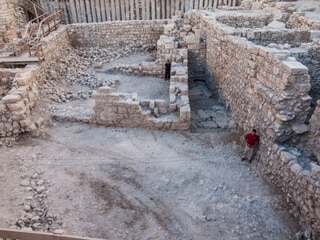Joseph ben Matityahu told about Hasmonean Jerusalem, but only now are the remains of a building from this period of the city being uncovered in archaeological excavations by the Antiquities Authority in the City of David in the National Park surrounding the walls of Jerusalem

Over the past few months, the remains of an impressive building from the Hasmonean period (2nd century BC) have been uncovered in excavations conducted by the Antiquities Authority in the Givat parking lot in the City of David, in the National Park surrounding the walls of Jerusalem. The excavations are funded by the Friends of the City of David.
The wide walls of the building (over a meter wide) are built of polished limestones that were laid using the "heads and patinas" method, a construction method typical of the Hasmonean period.
Inside the building, which rises to a height of about 4 m and whose area is about 64 square meters, many pottery vessels were discovered, but it was mainly the coins that surprised the researchers: these testified that the building was built at the beginning of the 2nd century BC and continued to During the Hasmonean period, during which it underwent substantial changes within itself.
- Physical activity during the Hasmonean period - Dr. Yehiam Sorek
- The priesthood as you did not know it - Matthew turns over in his grave
- The wall of Jerusalem from the Hasmonean period was uncovered on Mount Zion
According to Dr. Doron Ben Ami and Yana Chachanovitz, the managers of the excavation on behalf of the Antiquities Authority, "the importance of this discovery is mainly in view of the conspicuous paucity of the buildings of the Hasmonean city of Jerusalem in the archaeological research, and this despite the many excavations that have been conducted there so far.
With the exception of the remains of the city's fortifications, which were discovered in various parts of Jerusalem, pottery and other small finds, so far the buildings of the city themselves have not been uncovered, and this discovery bridges a certain gap in the settlement sequence of Jerusalem. The Hasmonean city that we know well from the historical descriptions of Joseph ben Matityahu suddenly receives a tangible expression".

2 תגובות
Perhaps there is a possibility to integrate Maccabean architecture in modern architecture. It is not only for these aesthetic reasons that structural advantages should be adopted.